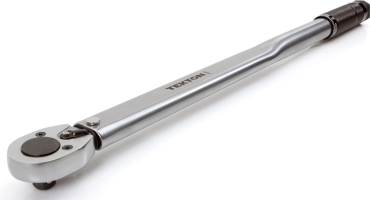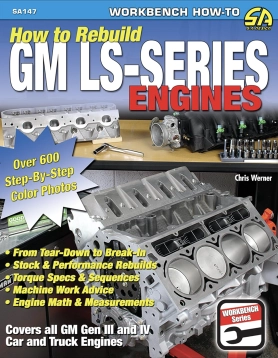This post covers the key torque specs for the 5.3 LS engine, along with some tips for proper installation and maintenance.
5.3 LS Engine Torque Specs
| Component | Torque Specification | Notes / Sequence |
|---|---|---|
| Cylinder Head Bolts | 22 lb-ft (30 N·m) → 44 lb-ft (60 N·m) → 90° turn | Torque in spiral/cross pattern from center outward; TTY bolts, do not reuse |
| Intake Manifold Bolts | 89 lb-in (10 N·m) | Torque in cross pattern starting from center |
| Main Bearing Caps | 70 lb-ft (95 N·m) | Torque in crisscross pattern for even pressure |
| Connecting Rod Bolts | 40 lb-ft (54 N·m) + 90° turn | Follow manufacturer specs if using ARP bolts |
| Valve Cover Bolts | 89 lb-in (10 N·m) | Tighten evenly around cover to prevent leaks |
| Oil Pan Bolts | 106 lb-in (12 N·m) | Torque from center outward in crisscross pattern |
| Harmonic Balancer Bolt | 74 lb-ft (100 N·m) | Single bolt; check model-specific requirements |
| Throttle Body Bolts | 89 lb-in (10 N·m) | Evenly tighten in cross pattern |
| Water Pump Bolts | 106 lb-in (12 N·m) | Torque evenly; avoid over-tightening |
| Fuel Rail Bolts | 18 lb-ft (25 N·m) | Tighten gradually in sequence |
| Camshaft Retainer Bolts | 18 lb-ft (25 N·m) | Torque evenly; check for specific engine year |
| Timing Cover Bolts | 89 lb-in (10 N·m) | Torque in a crisscross pattern |
| EGR Valve Bolts | 18 lb-ft (25 N·m) | Even tightening |
| Thermostat Housing Bolts | 18 lb-ft (25 N·m) | Torque evenly |
| Exhaust Manifold Bolts | 25 lb-ft (34 N·m) | Torque in sequence from center outward |
Related Oil Drain Plug Torque Chart(For ALL Car Models)
Best Torque Wrench for 5.3 LS
1. TEKTON 1/2-Inch Drive Micrometer Torque Wrench (25–250 ft-lb)

A reliable analog torque wrench perfect for working on the 5.3 LS engine.
Features:
- Adjustable torque range: 25–250 ft-lb
- Accurate click-style mechanism for precise tightening
- Durable steel construction for long-lasting use
- Suitable for cylinder head, rod, and main cap bolts
- Easy-to-read scale for both ft-lb and N·m units
2. eTORK Digital Torque Wrench 1/2″ Drive (25–250 ft-lb)

A high-precision digital torque wrench for exact measurements on LS engine components.
Features:
- Digital readout with backlit display for easy visibility
- Adjustable torque range: 25–250 ft-lb (34–339 N·m)
- Audible and visual alerts when the target torque is reached
- Works with both clockwise and counterclockwise tightening
- Ideal for TTY bolts and critical engine fasteners
3. How to Rebuild GM LS-Series Engines (Book)

Comprehensive rebuild manual for GM LS engines, including the 5.3 LS.
Features:
- Step-by-step instructions for engine disassembly and assembly
- Detailed diagrams of torque sequences and fasteners
- Covers 4.8L, 5.3L, 6.0L, and 6.2L LS engines
- Includes tips on common issues and performance upgrades
- Perfect for DIY mechanics and professional rebuilders
Related Perkins Engine Torque Chart(For All Models/Series)
Key 5.3 LS Engine Torque Specs
Below are the main torque specifications for the 5.3L LS engine. These numbers apply to most versions.
1. Cylinder Head Bolts
- Torque Sequence: Torque in three steps using the recommended pattern (spiral or cross pattern from the center outward)
- Step 1: 22 lb-ft (30 N·m)
- Step 2: 44 lb-ft (60 N·m)
- Step 3: 90° turn (final torque)
Cylinder head bolts are torque-to-yield (TTY) in most LS engines, meaning they are designed to stretch slightly for proper clamping. Never reuse TTY bolts.
2. Intake Manifold Bolts
- Torque: 89 lb-in (10 N·m)
- Sequence: Torque in a cross pattern starting from the center outward
This ensures even sealing of the intake manifold and prevents vacuum leaks, which can affect engine performance.
3. Main Bearing Caps
- Torque: 70 lb-ft (95 N·m)
- Sequence: Torque in a crisscross pattern to evenly distribute pressure
Main caps secure the crankshaft. Correct torque is essential to avoid bearing failure.
4. Rod Bolts
- Torque: 40 lb-ft (54 N·m) + 90° turn (for ARP or aftermarket bolts, follow manufacturer specs)
Connecting rod bolts are critical to engine durability, especially under high RPM and load conditions.
5. Valve Covers
- Torque: 89 lb-in (10 N·m)
- Sequence: Tighten evenly around the cover
Over-tightening valve covers can crack the gasket or cover, leading to oil leaks.
6. Oil Pan Bolts
- Torque: 106 lb-in (12 N·m)
- Sequence: Start from the center and move outward in a crisscross pattern
Ensures proper sealing of the oil pan and prevents leaks.
7. Harmonic Balancer Bolt
- Torque: 74 lb-ft (100 N·m)
- Sequence: Single bolt, but check for specific engine model requirements
The harmonic balancer plays a critical role in dampening engine vibrations, so proper torque is essential.
Related Engine Oil Pump Types(7 Pumps & Functions)
Overview of the 5.3 LS Engine
The 5.3L LS engine belongs to GM’s LS small-block family, which debuted in the late 1990s. It’s a V8 engine with a displacement of 5.3 liters (325 cubic inches) and is widely used in vehicles such as the Chevrolet Silverado, GMC Sierra, Tahoe, Suburban, and Camaro.
Key features of the 5.3L LS engine include:
- Aluminum or cast iron block (depending on the model year)
- Active Fuel Management (AFM) on certain versions
- Overhead valves (OHV) with two valves per cylinder
- High-flow cylinder heads for better performance
- Compatibility with a wide range of performance upgrades
Related Engine Coolant Color Chart(For All Coolant Types)
Why Torque Specs Matter
Torque specifications are more than just numbers, they are essential to engine health. Properly torqued bolts ensure:
- Correct clamping force – Ensures components are securely fastened without over-compressing, which could lead to damage.
- Avoiding leaks – Correct torque prevents oil or coolant leaks, especially in areas like the cylinder head and intake manifold.
- Engine longevity – Over-torquing or under-torquing can cause warping, stripped threads, or engine failure.
- Consistent performance – Proper torque ensures the engine operates as designed, maintaining power and efficiency.
Ignoring torque specs can lead to costly repairs, so always use a reliable torque wrench and follow the manufacturer’s recommended procedure.
Tips for Torquing the 5.3 LS Engine
- Use a calibrated torque wrench – Cheap or worn-out tools can give inaccurate readings.
- Clean threads – Remove dirt, oil, or old threadlocker to ensure accurate torque.
- Lubricate when required – Some bolts require light oil or assembly lube for proper torque; check your service manual.
- Follow torque sequence – Especially important for cylinder heads and main caps to prevent warping.
- Retorque after initial run – Some bolts, like those in the cylinder head, may require a follow-up torque after the engine reaches operating temperature.
Related Oil for LS1 Engine(Top 3 Best 2025)
FAQs
How much torque does a 5.3 LS engine have?
The 5.3 LS engine produces approximately 320–335 lb-ft of torque, depending on the year, configuration, and whether it has Active Fuel Management (AFM).
What are the torque specs on a LS engine?
- Cylinder head bolts: 22 lb-ft → 44 lb-ft → 90° turn
- Intake manifold bolts: 89 lb-in
- Main bearing caps: 70 lb-ft
- Rod bolts: 40 lb-ft + 90° turn
- Valve cover bolts: 89 lb-in
- Oil pan bolts: 106 lb-in
Is there a difference between 5.3 Vortec and 5.3 LS?
Yes. The 5.3 Vortec is an earlier generation small-block engine, typically with a cast-iron block and less advanced features, while the 5.3 LS is part of GM’s newer LS family, offering lighter weight, improved efficiency, and better aftermarket support.
Is a 5.3 LS engine better than a 6.0 LS?
It depends on your needs. The 6.0 LS generally produces more power and torque (about 360–380 lb-ft), but the 5.3 LS is lighter, more fuel-efficient, and often sufficient for trucks, SUVs, and daily driving.
What is the difference between a 5.3 LS and a 5.7 LS?
The 5.3 LS has a 5.3-liter displacement, while the 5.7 LS (like the LS1/LS6) has 5.7 liters, producing higher horsepower and torque. The 5.7 typically uses higher-performance components, while the 5.3 is more geared toward reliability and efficiency.
What are the torque specs for a 4L60E?
The 4L60E transmission has several torque specs depending on the component:
- Transmission pan bolts: 89 lb-in
- Valve body bolts: 89 lb-in
- Pump cover bolts: 18 lb-ft
- Always refer to the service manual for exact specs, as they vary by model year.
Final Words
The 5.3 LS engine is a versatile and robust powerplant, but proper assembly and maintenance rely heavily on using the correct torque specifications. From cylinder heads to rod bolts, following the recommended torque values ensures engine reliability, performance, and longevity.
Always use a torque wrench, follow the proper sequence, and consult your specific engine’s manual for any variations. With the right attention to detail, your 5.3 LS engine can provide years of dependable performance.

